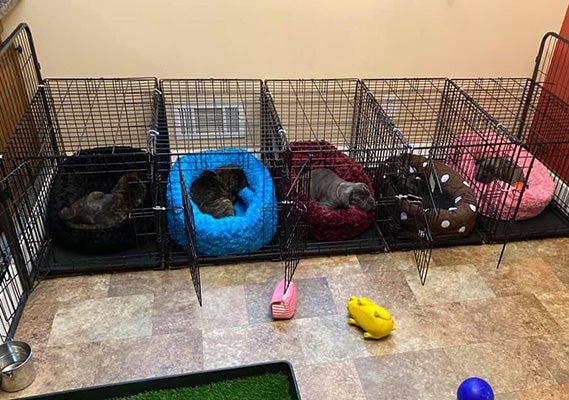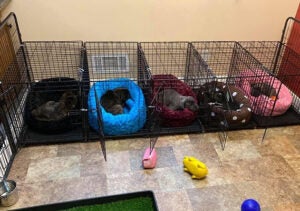
This is the third in a series on early socialization and training that breeders can do with young puppies to help them adapt to life in their future new homes.
New puppy owners often do not see the benefits of crate training beyond short-term use as a tool to aid in housetraining, something to be done away with once that has been accomplished.
As a breeder, you are the perfect person to let them know that crates are a valuable lifetime tool. They provide dogs a haven, a place of their own – a quiet place to nap and a safe place to travel in.
Crates bring peace of mind when the dog needs to be in a safe place while guests or workers are in the home and anytime owners cannot directly supervise. A puppy can get into big trouble in the 10 minutes it takes to go to the laundry room to put the clothes in the dryer! Humans like having their own space and dogs, being denning animals, usually do too.
The sudden separation from dam and littermates can be very distressing for young puppies, so familiarizing them with crates early will help them be more comfortable when they are taken to a place full of strange people and smells.

If you have a litter of 12, it isn’t practical, or even possible, to set up an individual crate for each puppy but you can still set up a few crates in their ex-pen to help them get used to the idea. Some crates can be set up with the ex-pen connected to the front, so that they do not take up room in the pen itself. You can also take turns having puppies spend short periods of time in a crate by themselves, for meals or just to enjoy a treat – far better than no crate introduction at all!
Of course, if you have smaller litters, it may be easy for your puppies to start sleeping in crates at an early age, 6 weeks or so.
Encourage your puppy buyers to always use a crate when transporting their puppy by car. It is the safest way, and you can take puppies for short rides before sending them home with their new owners.
More tips for you to give your puppy buyers:
- Keep an open crate in the puppy’s exercise pen and put treats and toys inside it.
- Feed puppy in crate.
- From day one, establish a routine. Part of every morning and afternoon should include naptime in the crate.
- If the crate is wire, cover it, except for most of the front, to make it feel cozier and less exposed.
- Allowing puppies to “cry it out” can create negative associations with being crated. Crate the puppy for short periods of time and let him or her out before showing signs of stress.
- For convenience, consider more than one crate: one upstairs, one downstairs, and one that you keep in the car.

